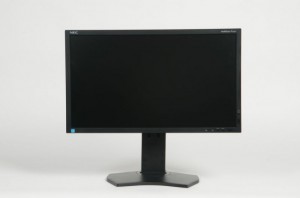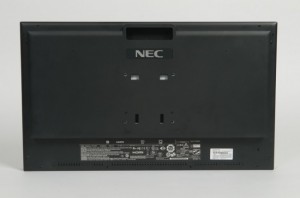Although NEC’s lineup offers the device to suit all tastes, from the most affordable and high-quality models to professional, yet in the first place, this company is known & thanks to the last – and the recently introduced model NEC P232W applies to this class. And today we get the chance to bring the complete review for this monitor.
NEC has successfully resisted all the newfangled trends in the design of monitors – all of its models, including the most recent, have a brand easily recognizable appearance, in which there is long-term continuity.
Here and in the NEC P232W we see lick shapes, glossy surfaces, metal inserts and smooth curves. Non-marking black matte plastic, clear straight lines, massive elements of the case – it is difficult to imagine how this monitor will fit into the home environment, but on the desktop designer it will look absolutely natural.
NEC P232W replaced the 2010 year PA231W, and generally repeats its design, the differences between them are minimal (for example, the monitor was 1 mm thinner). Despite the transition to LED-backlight, the thickness of the display is still big, about 7 cm power supply is built into the monitor, someone will like it (no extra “boxes”), someone – no (theoretically, in the event of its down replacement will be more problematic.) Hardware menu button, located on the front panel in the lower right corner, pressed tightly and relatively clear. Activity LED glows bright blue and orange in standby mode. Note the LED is so bright that it can create discomfort for some users to adjust the intensity of the glow by using the supplied software MultiProfiler (it also allows you to change the display settings in Windows, for which the monitor must be connected to a PC via USB). Width of the frame is around the screen is about 17 mm, it looks fine enough.

NEC P232W offers a full suite of video jacks – VGA, DVI-D, DisplayPort and HDMI. There is also a two inputs and two outputs USB (used for connecting peripherals, and connect the monitor to two different PCs, switching between them with menus OSD).
Another USB port is on the right. Video cables are connected from the bottom, which is logical, given that this model allows wall mounting (VESA 100×100). Leg – one of the most massive, we’ve seen. In terms of the available degrees of freedom is all right – you can change the angle of the screen, rotate around the vertical axis, the adjustment of the height and translate into portrait mode. Stand of NEC P232W is very broad and stable, all connections are tight, and the monitor is not in a modern solid (9.2 kg). For easy transport to the top of the rear panel has a large enough dent for which the display is much easier to raise – and that leg is not apart, it can be locked in the folded position with the side latch.
Your monitor can attach to the wall, it is necessary to unfasten the leg, which are hidden under the mounting holes.
Menu
The menu of NEC P232W is as classic as the design – for example, in the version in the existing monitor NEC 2080UX + (released in 2003), the menu looks almost the same as that in this model, released a couple of months ago.
The menu has a strip of icons; the transition to the end, there is a drop-down list of options. First is the brightness / contrast (change of the last available only with analog connection), here turn eco mode, and controls the degree of illumination (parameter black). In the next section, adjust the picture position on the screen, the image sharpness and the display of images in a non-native resolution for your monitor. What follows is, in fact, the main section of the menu, the icon labeled RGB. It is available to the user to select one of four pre-defined video modes (plus one programmable used in the calibration of the monitor using the correction LUT-tables), color temperature, as well as fine-tuning of each of the six colors (red, yellow, green, blue, indigo and magenta) separately in three different settings – tint (hue), brightness (offset) and saturation (saturation). In addition, there are also available, and advanced settings – at their choice, a new 12-page menu, which overlaps with the settings from the main menu, plus an additional adjustable range (from 0.5 to 4.0 in increments of 0.1), the correction of flat color brightness (it can help to achieve a more uniform brightness due to a decrease in its level), include faster response, automatic brightness control, ambient light compensation, etc.
The next section for NEC P232W are “tools”, that allows you to set the display mode of PIP, to switch between USB-input, which is connected to different PC, change the method of determining the video input to which the signal, turning off the monitor when the signal disappears, etc. In the next section, select the language, OSD position on the screen and if necessary, to reset to factory settings. Section “eco” reports very useful information about the “carbon economy”, and in the last section, “information”, information is displayed about the connection, the video settings, etc.
Inside
In NEC P232W monitor uses 8-bit AH-IPS panel production LG – LM230WF3-SLE1. Its 23″, 16:9 aspect ratio, resolution – 1920×1080 pixels (pixel size in this case is 0.27 mm). Also it uses a 14-bit programmable color correction table (3D LUT). As this model employs W-LED backlight talking about full coverage of Adobe RGB space is not, the monitor supports only the standard color gamut.
In the sRGB preset brightness of 72.5 cd / m ² (if desired, you can change it), graphic color temperature is a rather flat line at ~ 6600K, gamma curve is also quite smooth, with some reduction in the dark areas and increasing – in light, medium importance in this case corresponds to 2.24. In this mode, the monitor’s color gamut covers 93% sRGB and 74% – Adobe RGB.
In the REC-BT709 (as stated in the manual, designed for high-definition televisions) the brightness, color temperature and other parameters remain the same, but change the adjustment range – its value is somewhat high for a dark image (which leads to a richer picture), then it decreases and reaches a minimum at 2.15 at 60% gray, then increases and reaches 2.2 in the light zone.
High Bright mode in NEC P232W offers maximum brightness and low power consumption at the factory setting. In fact the menu brightness set to 70% and is 177.5 cd / m ². If we increase it to 100%, the brightness level is raised to 277 cd / m ², while the contrast is 670:1. Note that in this mode, there is no limit in the brightness, while in others (eg, sRGB) monitor can independently enter “compensation” is too large or small values, which is shown repainting this setting from black to purple.

In Full mode displays the full gamut, without any restrictions or emulations – is evident in the chart, where the coverage in the green region is much higher than with sRGB or REC-BT709.
To calibrate the color accuracy was quite acceptable to the naked eye to see any problem, it was not – the results of measurements of the average deviation was 2.54 delta E (remember, it is believed that the human eye is unable to tell the difference, if this parameter is less than 3). After calibration, of course, the situation has improved.
Uniformity of illumination tested in Video High Bright twice, once at full brightness Uniformity in the value of Off (disabled uniformity correction) and the second time – at 70% brightness Uniformity = 5 (maximum value, available only with a decrease in brightness to the very 70%). In the first case, the average brightness value from measurements at 35 points on the screen was 277 cd / m ² (maximum – 296 cd / m ², minimum – 246 cd / m ²), uniformity of illumination was 94%, which is a very good result. However, after the Uniformity has changed dramatically: the average brightness has dropped to 218 cd / m ², while the maximum was 221 cd / m ², minimum – 214 cd / m ². Uniformity thus reached 98.6%, which is the best result of all we’ve seen so far.
Screen at the NEC P232W is matt, crystal effect is weak and the normal use of the monitor is almost imperceptible. Glow-effect also appears not too much, mostly at high brightness in a completely black image area sufficiently large angle. Viewing angles on this model – traditional IPS-matrix, with large deviations brightness decreases uniformly, rejecting the vertical picture begins to barely perceptible “warm up” across – on the contrary, there are cool colors.
Results
In the face of NEC P232W monitor, we see a classic for professional color – excellent image quality, a great way to set it up, 14-bit programmable LUT-table. In this case, NEC does not change the traditions and preserves the continuity of the design over the years, in the eyes of supporters of the brand is an additional plus. Except that you can complain to the relatively high cost, especially when compared with “normal” model is similar to the diagonal, but in this case, the user is well aware, for which he pays.
Pros:
+ Excellent image quality
+ Ability hardware calibration
+ High uniformity of illumination
Cons:
– No expanded color range
This was all regarding the NEC P232W monitor.

